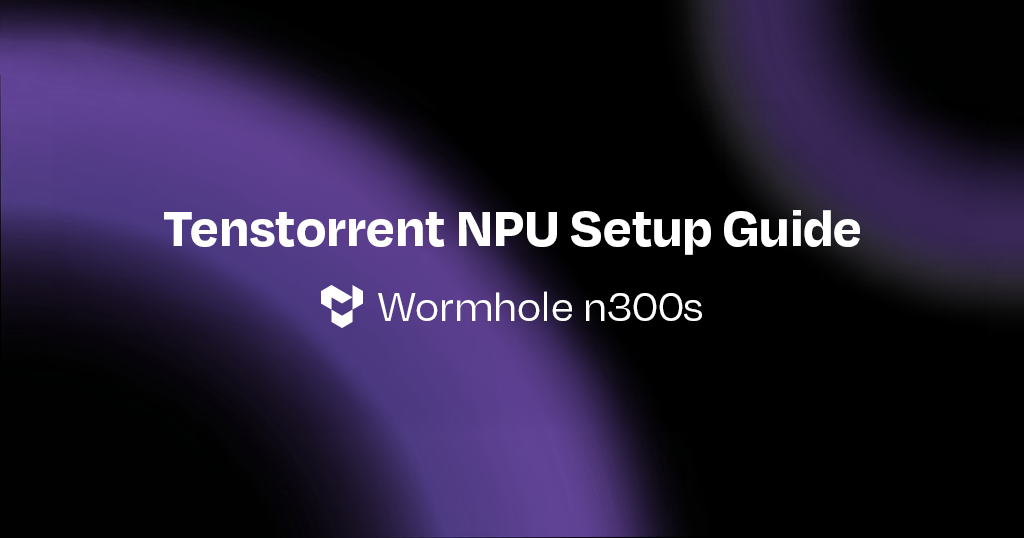In this guide, we will walk you through the setup process for your Tenstorrent NPU wormhole (N300S), including hardware installation, driver setup
1. Prerequisites
Grayskull is no longer supported by Tenstorrent. If you are still using Grayskull, you will need to rely on the last available software versions or consider upgrading to a newer Tenstorrent NPU.
Tenstorrent’s last supported software versions for Grayskull include:
- TT-Firmware:
fw_pack-80.14.0.0.fwbundle - TT-KMD:
ttkmd_1.31 - TT-Buda:
v0.19.3 - TT-Metalium:
v0.55
2. : Install TT-KMD for Tenstorrent Wormhole N300S
First, installing the Kernel-Mode Driver (TT-KMD) is an essential step for setting up the
Tenstorrent Wormhole N300S system correctly.
Install Software Dependencies
sudo apt update && sudo apt install -y wget git python3-pip dkms cargo python-is-python3
Install the driver (TT-KMD) by running these commands in the terminal:
git clone https://github.com/tenstorrent/tt-kmd.git
cd tt-kmd
sudo dkms add .
sudo dkms install "tenstorrent/$(./tools/current-version)"
sudo modprobe tenstorrent
## To uninstall ex.. 1.31:./tools/current-version
sudo modprobe -r tenstorrent
sudo dkms remove tenstorrent/1.31 --all
## Driver Module
root@test:/# lsmod |grep -i tens
tenstorrent 49152 0
3. Update Device TT-Firmware with TT-Flash
Next, You need to install the TT-Firmware file using the TT-Flash utility.
You only need to update the firmware once once when the card is first unboxed or when updating to a new firmware version.
To Build from git (development):
## Building the repository
sudo apt install cargo
curl --proto '=https' --tlsv1.2 -sSf https://sh.rustup.rs | sh
source "$HOME/.cargo/env"
git clone https://github.com/tenstorrent/tt-flash.git
cd tt-flash
## (Optional) Virtual environment
python -m venv venv
source venv/bin/activate
pip install --upgrade pip
pip3 install .
root@test:/opt# tt-flash -h
usage: tt-flash [-h] [-v] [--sys-config SYS_CONFIG] [--no-color] [--no-tty] {flash,verify} ...
Version: 3.1.1
optional arguments:
-h, --help show this help message and exit
-v, --version show program's version number and exit
--sys-config SYS_CONFIG
Path to the pre generated sys-config json
--no-color Disable the colorful output
--no-tty Force disable the tty command output
command:
{flash,verify}
verify Verify the contents of the SPI. Will display the currently running and flashed bundle version of the fw and checksum the fw against either what was flashed previously according the the file system state, or a
given fw bundle. In the case where a fw bundle or flash record are not provided the program will search known locations that the flash record may have been written to and exit with an error if it cannot be found
or read.
Download TT-Firmware and Update:
git clone https://github.com/tenstorrent/tt-firmware.git
cd tt-firmware/
root@test:/opt/tt-firmware# ls
experiments fw_pack-80.15.0.0.fwbundle latest.fwbundle LICENSE LICENSE_understanding.txt README.md SUMMARY.md
## Since four cards are installed in this system, all four are shown in the update process.
## However, the output will vary depending on the actual number of installed cards.
root@test:/opt/tt-firmware# tt-flash --fw-tar fw_pack-80.15.0.0.fwbundle --force
Stage: SETUP
Searching for default sys-config path
Checking /etc/tenstorrent/config.json: not found
Checking ~/.config/tenstorrent/config.json: not found
Could not find config in default search locations, if you need it, either pass it in explicitly or generate one
Warning: continuing without sys-config, galaxy systems will not be reset
Stage: DETECT
Stage: FLASH
Sub Stage: VERIFY
Verifying fw-package can be flashed: complete
Verifying Wormhole[0] can be flashed
Verifying Wormhole[1] can be flashed
Verifying Wormhole[2] can be flashed
Verifying Wormhole[3] can be flashed
Stage: FLASH
Sub Stage FLASH Step 1: Wormhole[0]
ROM version is: (80, 14, 0, 0). tt-flash version is: (80, 15, 0, 0)
Forced ROM update requested. ROM will now be updated.
Board will require reset to complete update, checking if an automatic reset is possible
Success: Board can be auto reset; will be triggered if the flash is successful
Sub Stage FLASH Step 1: Wormhole[1]
ROM version is: (80, 14, 0, 0). tt-flash version is: (80, 15, 0, 0)
Forced ROM update requested. ROM will now be updated.
Board will require reset to complete update, checking if an automatic reset is possible
Success: Board can be auto reset; will be triggered if the flash is successful
Sub Stage FLASH Step 1: Wormhole[2]
ROM version is: (80, 14, 0, 0). tt-flash version is: (80, 15, 0, 0)
Forced ROM update requested. ROM will now be updated.
Board will require reset to complete update, checking if an automatic reset is possible
Success: Board can be auto reset; will be triggered if the flash is successful
Sub Stage FLASH Step 1: Wormhole[3]
ROM version is: (80, 14, 0, 0). tt-flash version is: (80, 15, 0, 0)
Forced ROM update requested. ROM will now be updated.
Board will require reset to complete update, checking if an automatic reset is possible
Success: Board can be auto reset; will be triggered if the flash is successful
Sub Stage FLASH Step 2: Wormhole[0] {n300}
Writing new firmware... SUCCESS
Firmware verification... SUCCESS
Initiating local to remote data copy
Sub Stage FLASH Step 2: Wormhole[1] {n300}
Writing new firmware... SUCCESS
Firmware verification... SUCCESS
Initiating local to remote data copy
Sub Stage FLASH Step 2: Wormhole[2] {n300}
Writing new firmware... SUCCESS
Firmware verification... SUCCESS
Initiating local to remote data copy
Sub Stage FLASH Step 2: Wormhole[3] {n300}
Writing new firmware... SUCCESS
Firmware verification... SUCCESS
Initiating local to remote data copy
Flash and verification for all chips completed, will now wait for n300 remote copy to complete...
Remote copy completed
Stage: RESET
Starting PCI link reset on WH devices at PCI indices: 0, 1, 2, 3
Finishing PCI link reset on WH devices at PCI indices: 0, 1, 2, 3
FLASH SUCCESS
4. Set Up HugePages
Your system allocates dedicated memory using HugePages to accelerate communication with Tenstorrent devices. Set up HugePages by running these commands in the terminal:
# Install `.deb`
wget https://github.com/tenstorrent/tt-system-tools/releases/download/upstream%2F1.1/tenstorrent-tools_1.1-5_all.deb
sudo dpkg -i tenstorrent-tools_1.1-5_all.deb
# Start Services
sudo systemctl enable --now tenstorrent-hugepages.service
sudo systemctl enable --now 'dev-hugepages\x2d1G.mount'
# System Reboot
sudo reboot
5. Install the System Management Interface (TT-SMI)
Install Tenstorrent Software Management Interface (TT-SMI):
To Build from git (development):
# Clone the repository
git clone https://github.com/tenstorrent/tt-smi.git
cd tt-smi/
# Create and activate a virtual environment
python3 -m venv .venv
source .venv/bin/activate
# Upgrade pip
pip3 install --upgrade pip
# Install protobuf (required for Ubuntu 22.04)
sudo apt install -y protobuf-compiler
# Install tt-smi
pip3 install .
# Usage: Command line arguments
tt-smi [-h] [-l] [-v] [-s] [-ls] [-f [filename]] [-g] [-r 0,1 ... or config.json]
# Run the TT-SMI utility
tt-smi
You will see a display with device information, telemetry, and firmware:
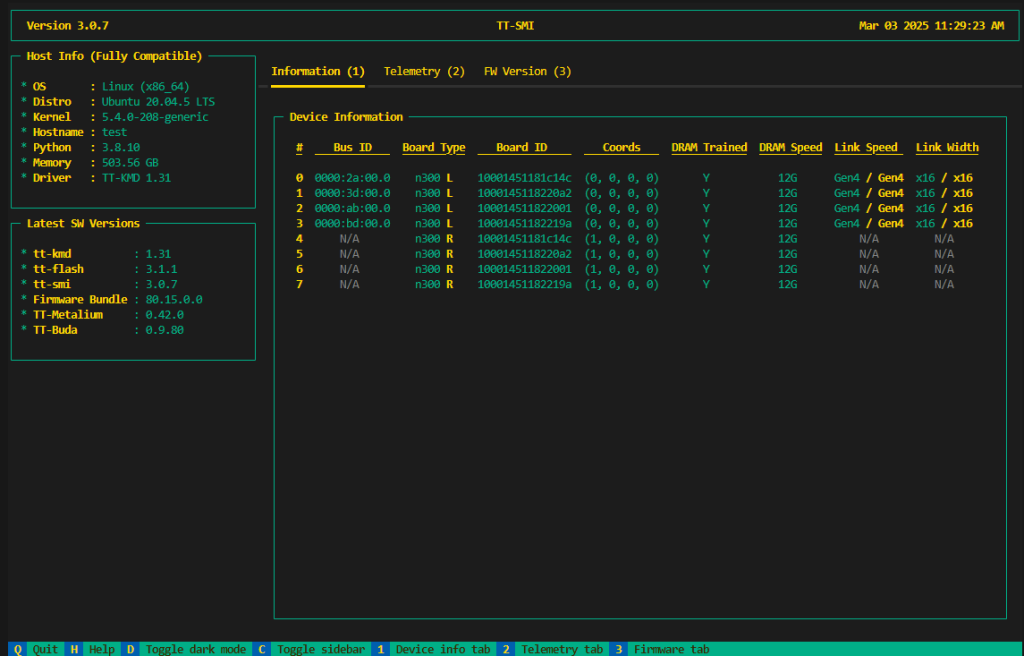
You can check the results of the firmware update to 80.15.0.0 applied previously.
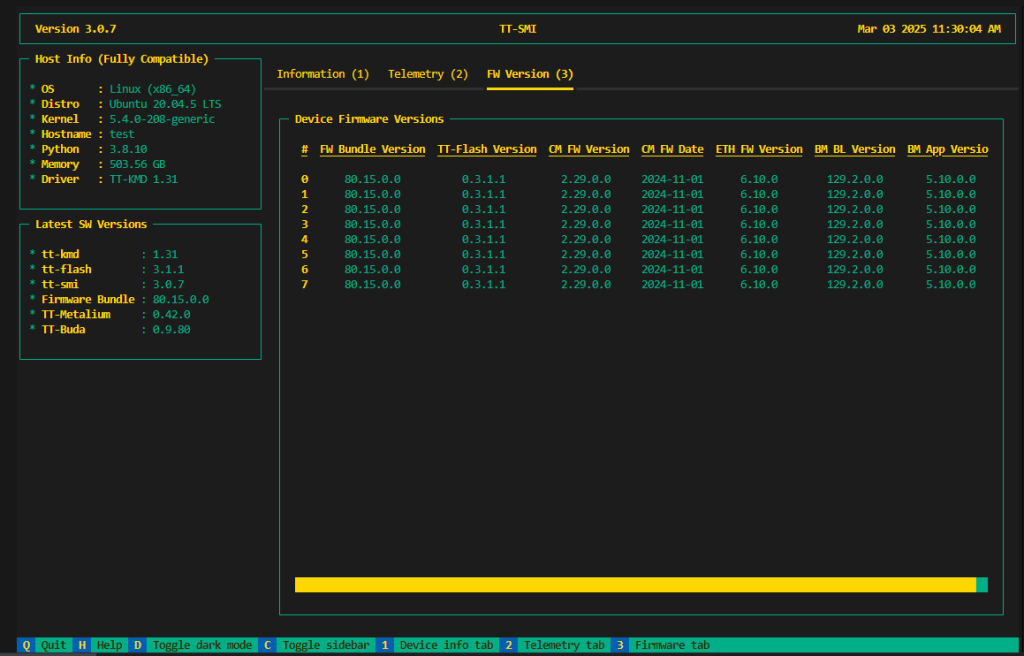
6. Optional : Multi-Card Configuration (TT-Topology)
If you have installed a multi-card Wormhole system (4 cards), install the Tenstorrent Topology utility and configure a mesh topology by running the following commands in the terminal.
TT-Topology is a command line utility used to flash multiple NB cards on a system to use specific eth routing configurations.
In this guide, we will walk you through the setup process for your Tenstorrent NPU, including hardware installation, driver setup, and SDK configuration.
Flash all the boards to default– set all eth port disables to 0 and reset coordinates to (0,0) for local chips and (1,0) forn300remote chips.- Issue a board level reset to apply the new flash to the chips.
- Generate a mapping of all possible connections and their type between the available chips.
Using a graph algorithm generate coordinates for each chip based on user input.These layouts are discussed in detail in the sections below.- Write the new coordinates to the chips.
- Issue a board level reset to apply the new flash to the chips.
Return a png with a graphic representation of the layoutand a .json log file with details of the above steps.
For other configurations or detailed explanations, please refer to this.
git clone https://github.com/tenstorrent/tt-topology.git
cd tt-topology
pip3 install --upgrade pip
pip3 install .
tt-topology -l mesh -p mesh_layout.png
Mesh
In the mesh layout is a trivalent graph where each node can have a max of 3 connection. The system assigns the coordinates using a BFS algorithm. Command to generate a mesh layout
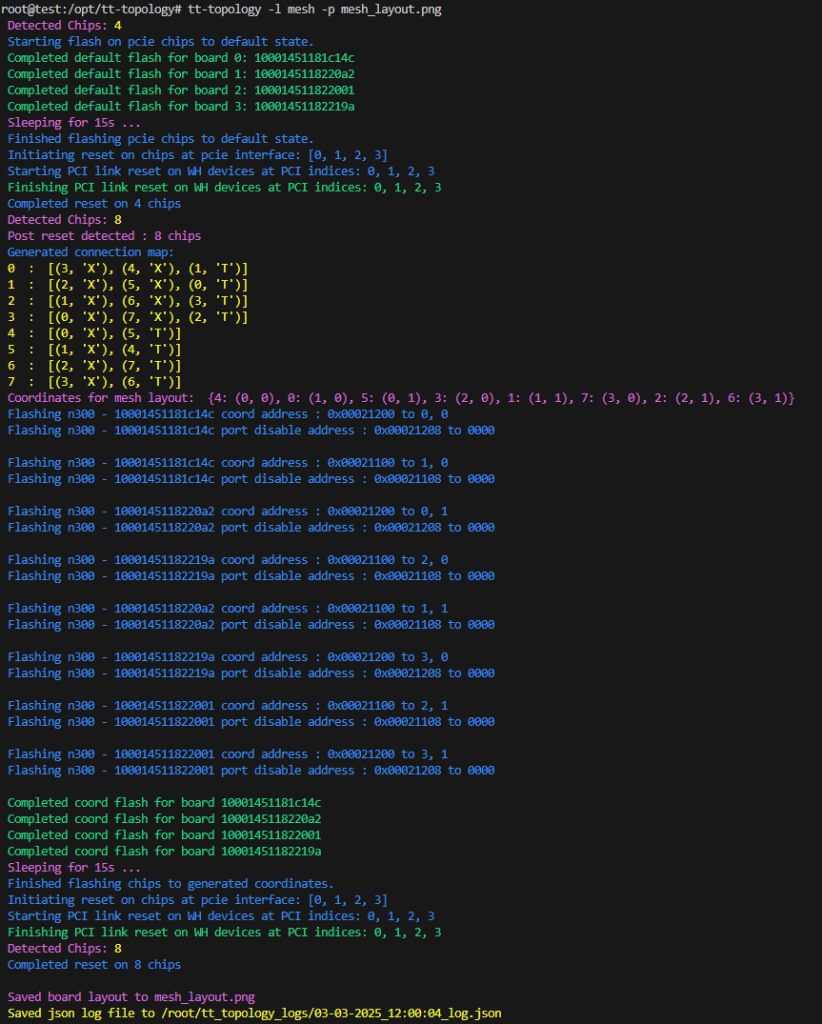
You can see the configuration as shown in the image below.
After completing the setup, you can check the Coords values by running tt-smi.
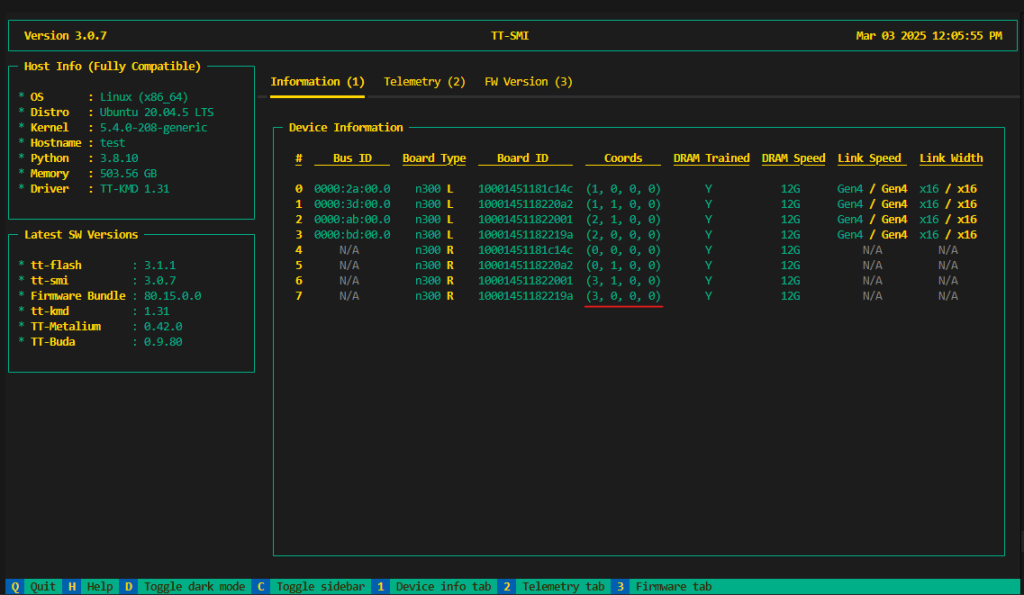
Now, all the basic configurations are complete.
Tenstorrent provides three open-source SDKs for developing on Tensix Processors:
- TT-Buda to run existing models
- TT-Metalium/TT-NN to build your own kernels and models
- TT-Forge/TT-MLIR to create, compile, and optimize graph operations
Each SDK will have its own system dependency requirements and installation process.
As of October 2024, TT-Buda development has been discontinued. It is planned to be integrated with other SDKs in the future.
TT-Metalium/TT-NN and TT-Forge/TT-MLIR are currently under active development.
In the next section, we will document the installation of the SDK and run example demos. N300S
Thank you.
